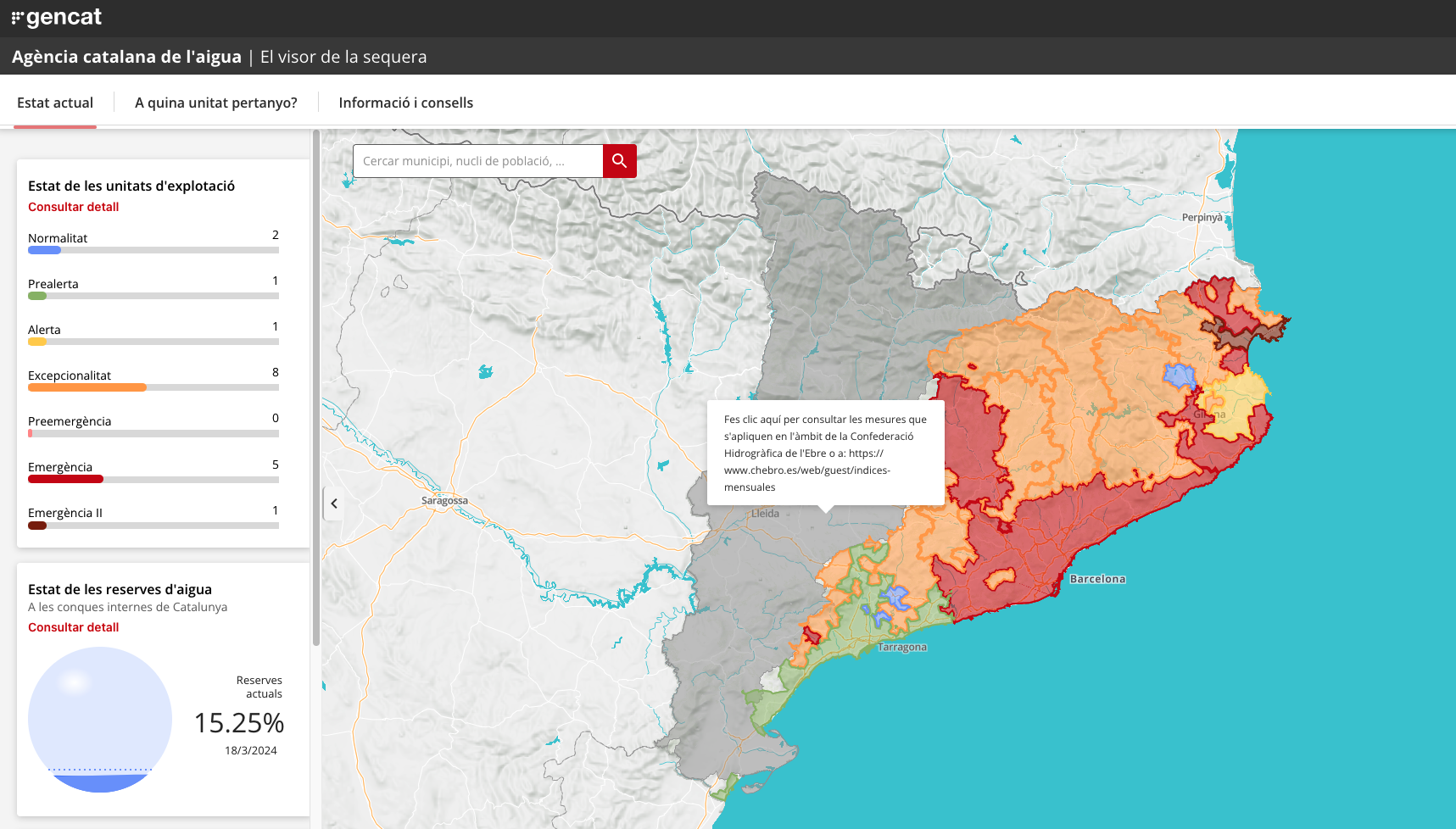Every Drop Counts
In drought-stricken Catalonia, the search for water solutions is on
Some of the wastewater that has been flushed or drained away from the town of La Llagosta, a 20-minute train ride north of Barcelona, ends up churning and bubbling through a lattice of grey pipes and containers under the scrutiny of a small team of researchers who view this material as a golden opportunity.
This team has several goals. One of those is to show that water purification does not have to be a linear process — wastewater in, freshwater out — but that along the way we can recover some marketable resources. Another is that it could be possible to power the process with the gas it produces. All this of course without wasting a drop of precious water, which is especially important given the location.
From their pop-up laboratories, these researchers run experiments using wastewater syphoned off from the much larger facilities at La Llagosta’s Wastewater Treatment Plant (WWTP)operated by the local water institution, Consorci del Besòs Tordera, which provided the space for the pilot.
We have biogas for energy exploitation, water for different reuses, and then the recovery of nutrients for use in agriculture. Teresa de la Torre, from Sorigué’s department of innovation.
The study led by Sorigué, a group of companies in the technology and water engineering, services, construction and materials sectors, as part the EU-funded WATER-MINING Project, adds extra circular steps to a linear purification process to obtain nitrogen, phosphates, biogas and, ultimately, high quality freshwater for potential agricultural, urban, leisure, environmental and industrial reuse.
“What we are doing here is a water treatment process that allows us to maximize the recovery of resources from the wastewater. We have biogas for energy exploitation, water for different reuses, and then the recovery of nutrients for use in agriculture,” Teresa de la Torre, from Sorigué’s department of innovation, says during a visit to the study in Catalonia, northeast Spain.
A Series of Circular Events
Speaking to REVOLVE from the project site, de la Torre explains that these valuable products are extracted through a series of different processes and reactions that can be used as needed.
One option at the pilot site is to take the wastewater as a base for biogas production, which is done by passing it through a unit filled with granular bacteria that can remove the organic material and convert it into the gas. In theory, this biogas could fuel the very wastewater treatment process from which it is extracted. De la Torre says the tests at the site suggest the repurposing of biogas in this way could help slash the energy required to power the treatment process by a quarter.
Another option being examined at the pilot is the extraction of nitrogen through a process that uses partial nitritation and bacteria to remove nitrogen gas without the need for energy-consuming aeriation.
A third option is to obtain phosphate using innovative crystalizing technologies that in this case are being applied by the European center of excellence for sustainable water technology (Wetsus). Removing phosphates from the water presents an opportunity to recover a finite resource and avoids the introduction of phosphorus into natural bodies of water, which in abundance can induce eutrophication. Phosphates and nitrogen are both immediately marketable commodities that can be used in agricultural fertilizers and reduce the farming sector’s reliance on imports.
Finally, a reverse osmosis unit at the end of the process can produce high-quality freshwater that can be reused in many different sectors and industries. These experiments are already bearing fruit, says de la Torre.
“The process we are studying here will allow us to reduce the energy consumption required for the water purification treatment by approximately 25% as well as recover almost 100% of water for agricultural, urban, environmental and industrial reuse,” she says.

A Race Against Climate Change
These preliminary results from the case study could not be timelier.
In early February, the Catalan regional government extended a state of emergency to over 200 towns and cities, including the capital Barcelona, amid the region’s worst drought since records began in 1916. This measure means that six million people, or 80% of Catalonia’s population, are facing tighter water restrictions including consumption caps for households and businesses, strict limitations for swimming pools, and a ban on using ornamental water features.
These steps came as reservoir levels in Catalonia’s internal basins, known as the Conques internes de Catalunya, shrunk to lows of around 15%. The internal basins, which drain into the Mediterranean and are managed by the Catalan Water Agency (ACA), account for 52% of the region’s toral area but are home to 92% of its population. They cover major settlements like Barcelona and Girona. The WWTP at La Llagosta falls within the affected area. Catalonia’s Ebro basins were not in drought conditions as of March 2024

The drought, which has been in force for three years and counting, is prompting Catalonia to rethink its models of water management. Empty swimming pools are not likely to be a big draw for tourists, who like in the rest of Spain help to prop up the local economy. Households, farms, and industry, which account for 44%, 36% and 20% of water consumption in the internal basin areas, are also feeling the pinch of water scarcity. As of February, households and businesses face a government-enforced consumption cap of 200 liters of water per day, which could yet be tightened if the drought worsens.
According to the Catalan government, residents of the region consume 117 liters per day on average, which is above the recommended minimum of 100 per individual per day set by the World Health Organization.
An Unreliable Sky
With the rain in Spain seemingly falling anywhere but Catalonia for the moment, authorities have launched a campaign to reduce water consumption with a campaign entitled ‘L’Aigua no cau del cel’ (‘The water does not fall from the sky,’ in English). This slogan conveniently sums up the regional government’s wider policy of pivoting to alternative water sources like desalination. When announcing the state of emergency measures on 1 February 2024, Pere Aragonès, the regional president of Catalonia, said that reclaimed water accounted for 55% of all the water reaching homes in the region.
The drought, which has been in force for three years and counting, is prompting Catalonia to rethink its models of water management.
This push for more desalination and purification is encapsulated by the plans from the central Spanish and Catalan regional governments to expand the Tordera and Foix desalination plants at a cost of 287 million and 180 million euros respectively. Desalination plants might offer a quick fix to drought conditions, but some critics of the strategy, including environmental groups, highlight the long-term economic, environmental, and energy costs and advocate instead for more nature-based solutions and a reflection on how we manage the systems we have.
Close Collaboration
When it comes to wastewater treatment in times of drought, the case study in La Llagosta demonstrates a feasible and valuable approach to the process, according to de la Torre, from Sorigúe. “In this drought context, we cannot afford to lose any water source that is available. The solutions being tested in the case study allow to reuse the water in an efficient way. They are technologies designed for the WWTP of the present, where every drop counts.”

“In the new era of circular economy, WWTPs must be converted into biorefineries, where resources are recovered and sold as products. It is not easy to transform a conventional WWTP into a biorefinery and it entails costs, which is the main limitation here. However, it is a must, and contexts like the emergency that we are now suffering in Catalonia due to the drought will boost this kind of concept,” she says.
De la Torre adds that the key to success in replicating this system is being flexible so that it can be applied in different ways depending on whether it is to be integrated into a new construction or retrofitted into an already existing plant.
Another crucial element is the engagement with local stakeholders, which is done through the creation of Communities of Practice. These stakeholders involve the likes of water authorities, universities, farmers, centers of technology, and industries. Together, they can outline and tackle market barriers while pushing for policies to boost wastewater treatment acceptance, de la Torre adds.
The solutions being tested in the case study allow to reuse the water in an efficient way. They are technologies designed for the WWTP of the present, where every drop counts.” Teresa de la Torre, Soriguédepartment of innovation.
María Jose Muñoz, innovation technician at Consorci del Besòs Tordera, adds in an interview with REVOLVE that “the implementation of the pilot in the La Llagosta WWTP allows the technology to be validated in a real environment.”
“The collaboration with different stakeholders at a local level allows us to learn their real needs and how they can be responded to. This project has allowed us to learn about different water generation and waste recovery technologies. It allowed us to advance in the integration of treatment plants into the circular economy by building systems that generate resources,” she concludes.
In the face of Catalonia’s enduring drought crisis, the quest for water sustainability has unveiled promising innovations in wastewater treatment. Beyond water recovery, these advances offer a beacon of hope for energy conservation. This dual focus on water and energy underscores the urgent need for holistic solutions in the face of climate challenges. As Catalonia navigates this race against climate change, embracing such integrated approaches can help to build a resilient and more sustainable future, where every drop truly counts.